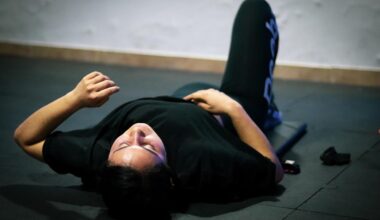Cross-Training Mistakes to Avoid for Parkour Performance
When pursuing parkour, effective cross-training is essential for enhancing your performance. However, many practitioners make common mistakes that hinder their progress. One significant mistake is neglecting flexibility training, which plays a pivotal role in executing parkour movements. Without proper flexibility, your body is less capable of achieving necessary ranges of motion during jumps and landings. Furthermore, improper strength training techniques can lead to injuries, as targeting the wrong muscle groups may have adverse effects. It’s crucial to build strength aerobically while ensuring proper form during exercises. Additionally, incorporating too much high-impact training without adequate recovery can result in burnout or injury. Therefore, balancing intensity and adequate recovery periods is vital. Not diversifying your training activities can also stall your progress. Aim to include a variety of activities such as gymnastics, climbing, and yoga to enhance skills holistically. Lastly, setting unrealistic goals can lead to disappointment. Progressing gradually with achievable goals will help maintain motivation and reduce the likelihood of injury. Therefore, understanding these common pitfalls can boost your parkour performance considerably, allowing you to navigate challenges effectively. Always remember to adjust your training strategy accordingly.
A common issue in cross-training is neglecting the importance of skill-specific training. Many parkour enthusiasts may focus heavily on strength and conditioning, ignoring the various techniques specific to parkour. Understanding fundamental skills like vaults, rolls, and precision jumps is necessary for performance enhancement. Incorporating skill drills into your routine every week will solidify your capabilities and ensure smooth transitions between movements. On the contrary, another mistake to avoid is underestimating cardiovascular fitness. Parkour demands not just strength but also endurance to perform repetitive movements effectively. Engage in aerobic exercises such as running or cycling a few times weekly to improve your cardiovascular conditioning. This will significantly enhance your stamina during parkour sessions, enabling you to perform for extended periods without fatigue. Moreover, skipping warm-up and cool-down routines can lead to injuries, especially in a discipline that places high demands on the body. Always prioritize warming up the body before workouts to reduce the risk of injury. Completing the session with a cool-down helps with muscle recovery. Integrating these practices into your routine ensures a safer and more productive training experience while achieving better overall parkour performance.
Diet and Nutrition Challenges
Another critical aspect of cross-training for parkour is nutrition. Many practitioners overlook the importance of consuming a balanced diet to fuel their bodies effectively. Poor nutrition can greatly impact your energy levels and performance during training. Consuming an excessive amount of processed foods and sugars can lead to poor energy management and hinder your recovery post-training. Instead, focus on nutrient-rich foods, including lean proteins, whole grains, healthy fats, and fruits and vegetables. Maintaining hydration is equally important as dehydration can drastically affect your performance. Therefore, drink enough water before, during, and after training sessions to keep your body functioning optimally. Furthermore, the misconception that supplements can replace healthy eating can lead to negative outcomes. While supplements may support your nutrition, they should not replace whole foods. Therefore, always aim to meet your nutritional needs through what you consume, ensuring a well-rounded approach to support your physical aspirations in parkour. Lastly, the timing of meals can also affect your performance; thus, paying attention to pre- and post-workout meals is essential to maximize training efficiency. Upgrade your diet to enhance your training routine significantly.
Moreover, seeking guidance or training independently can lead to various misunderstandings about parkour techniques. While solo practice is valuable, working with experienced coaches provides insightful feedback and meticulous guidance for skill improvement. Engaging in group training sessions enables exchanging ideas and tips with fellow enthusiasts, enriching your learning experience. Another common mistake is being overly focused on perfection. While striving for a high skill level is commendable, primarily through trial and error, acknowledging that mistakes are part of the learning process is vital. Rather than regretting falls and missteps, celebrate them as opportunities for growth. Practicing in environments that mimic real-world scenarios is essential too. Often, people train in sanitized spaces that minimize their understanding of how to navigate obstacles effectively. Get outside and train in diverse environments to hone your adaptability and creativity. This will better prepare you for the unpredictability you may face in real-life situations. Remember, learning to overcome fear is also essential; tackling obstacles at your own pace will help build your confidence gradually. Keeping these various factors in mind can significantly propel your progression and enjoyment of parkour while achieving substantial performance improvements.
Mindset and Goal Setting
Equally important to performance is cultivating the right mindset. Having a positive mindset towards training and challenges can enhance your experience in parkour. Fear often holds practitioners back from attempting new and advanced moves. Actively challenging that fear with gradual exposure can lead to increased confidence. Creating a supportive network with other practitioners is beneficial. Sharing experiences and encouraging each other fosters determination and motivation. Additionally, setting achievable, incremental goals that are specific to your progression allows you to focus effectively. Breaking down larger ambitions into smaller tasks promotes a sense of accomplishment, further fueling your training. Beyond this, keeping a training journal is an excellent way to document progress, evaluate performance, and plan workouts. Reflecting on past efforts allows you to identify strengths and weaknesses, thus refining your training plan. Also, understand that recovery plays a crucial role in maintaining your mental and physical health. Adequate rest and recovery will rejuvenate the body and mind, ultimately improving your performance. Importantly, surrounding yourself with inspiration, such as videos of skilled practitioners, can serve as motivation while ensuring you maintain focus while avoiding comparison with others.
Understanding the role of rest days in cross-training cannot be overstated. Many parkour practitioners tend to train vigorously without allowing their bodies sufficient time to heal. This approach can lead to overtraining symptoms, resulting in reduced performance and potentially increasing the risk of injury. Scheduling regular rest days into your training plan permits your muscles to repair themselves. Keeping the balance between active recovery and rest is equally essential; engaging in light activities like stretching or yoga can aid recovery without overexerting your body. Likewise, practicing mindfulness can significantly contribute to better performance and handling stress during training. Incorporating meditative practices into your routine helps improve focus, connecting your mind and body more effectively. Besides these, ensuring adequate sleep is crucial, as it aids recovery and enhances muscle performance. Sleep deprivation can diminish your coordination and strength, which are vital aspects of parkour. Aim for 7-9 hours of restorative sleep per night to maintain optimal physical functioning and ensure a consistently positive performance. Adopting these practices provides a solid foundation for becoming a better parkour practitioner while avoiding common cross-training mistakes that hinder progress.
Conclusion: Embrace the Journey
Finally, as you navigate your parkour journey, always strive for balance and enjoyment in your training. Embracing the process rather than fixating solely on outcomes will deepen your connection to parkour. Remind yourself that every practitioner progresses at a different pace and that focusing on personal milestones rather than external comparisons is far more beneficial. Also, be open to the idea that setbacks are part of growth; learning and adapting from challenges fosters resilience and a better understanding of your capabilities. Remember, parkour is not just about physical prowess but also about developing mental strength and adaptability. Regular reflection on your experiences and adopting a learner’s mindset will enhance your skills and yield a more enriching training experience. Make use of resources available in your community, including local classes or workshops. Engaging with coaches or advanced practitioners can provide invaluable insights and propel your skills forward. Ultimately, the journey of parkour is as rewarding as the accomplishments you achieve. Prioritize your wellness, seek guidance when needed, and genuinely enjoy the journey for sustained growth in this exhilarating discipline of parkour.
Ultimately, nurturing a profound connection to parkour while avoiding common cross-training mistakes fosters performance. Enjoyment and satisfaction stem from the positive mindset you create through the process. Always seek to maintain a holistic approach that encompasses mental and physical aspects, ensuring your journey is sustainable and fulfilling. Incorporating these tips into your training regimen will prepare you for new challenges and help you reach your personal best while enjoying the parkour journey.


